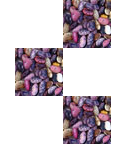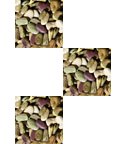Backpacking Tips
A-A+

Backpacking Equipment
- Use hi-tech fabrics which are light, breathe well, and – most important of all – dry incredibly fast:
- Mesh merino or micro-fiber baselayers: socks, pants, shirt, hat, gloves
- Sports bra (wire-free, supportive, low weight, evaporating sweat)
- Microfiber towels
- NO: sweatshirts, cotton t-shirts, cotton trousers, jeans, cotton socks, cotton underwear and thick towels.
- To dry your laundry faster, roll each item in a towel and squeeze it, before hanging for the final dry.
- After you have dried wet clothes and they are still damp, you can dry them using body heat by wearing them.
- When there is a chance for rain, put your equipment into sealed plastic bags, and insert a thick plastic bag into the equipment bag, and close inside all items.
- Put all your documents in a dry bag, and carry them with you at all times.
- When you wear bright colors (red, yellow, orange), you are seen from afar. It is efficient when you lag behind, or when people are looking for you, and it comes out great in photographs.
- When climbing to a cold place without all the equipment (such as to Poon Hill in the Annapurna trek, or to Gokyo Ri and Kala Patthar in the Everest trek): in addition to the thermal underwear layers on top, bottom, head, hands and feet, put on the gaiters, which block the wind between the shoes and the pants. In addition, empty the backpack and put inside only the down sleeping bag, folded (not squeezed). Your backpack will protect your back.
- Gaiters have different functions: they prevent rain drops and wet grass from leaking into the shoes, prevent thorny plants from sticking to the stockings, prevent entry of leeches, and when climbing volcanoes, also prevent pyroclasts from getting inside the shoes.
- In steep mountains like the Nepalese Himalayas, when it starts to rain or snow, reach the nearest guesthouse, and stay there. Heavy rain causes landslides, waterfalls, and large pools of deep brown water. The snow covers the trail so that it cannot be seen, and heavy snow causes avalanches. The safest place is indoors.
- Use a backpack which fits your body. A misfitting backpack will press and disturb you. When a pack fits well you can comfortably carry extra weight, because it transfers the weight through the skeletal system rather than forcing your muscles to carry the load.
- Boots fitted size: With the boot fully unlaced, move your foot as far forward in the boot as possible. If the boot is the proper size for your feet, you should be able to slip your index finger down inside the boot at the back of the ankle.
- Maintain your feet: rinse your feet with soap every day; keep your feet dry; use clean socks; cut your nails before you descent; while walking there is no need to smear the feet in ointments, the body keeps suitable fattiness naturally; cover blisters in a designated bandaid as early as possible.
- Drink boiled water or get a water purifier, and you will not need to buy mineral water along your trip.
- Take with you a small bottle to the airport (stainless steel/titanium), empty it before the hand luggage security check, and refill it in the gates' hall.
- Before flights and long journeys, secure the flashlight in the "off" position.
- Fly with your trekking boots on. In case your luggage does not arrive, you can manage gathering equipment – buying, renting, sharing with your friends, etc. The probability to find shoes in your size is low, and start trekking with new shoes is not recommended. In addition, your backpack will be lighter.
- It is not possible to fly a Power Bank in a checked-in bag. Some airlines allow to fly a Power Bank in your boarding handbag. Check with the airline.
- When using local transportation, put your backpack inside a waterproof bag, so it will not get dirty or wet (e.g. when the backpack is tied on the bus rooftop, together with chickens, or when it rains).
- Take a back belt for horseback ridings and snowmobiles.
- Camping tips:
- To those who suffer from cold (like me): thermal insulation from ground cold is more significant than insulation from air cold, therefor it is better to put an insulating sheet under the mattresses or under the tent, and use a mattress with high "thermal resistance" (I use Therm-a-Rest NeoAir XLite, 6.3 cm thick).
- A down sleeping bag is the lightest, most compressible and offers ultimate thermal insulation.
- It is much warmer to sleep naked inside a good insulating sleeping bag. You can also use a silk lining inside the sleeping bag, which improves the isolation, and is easy to wash.
- At cold nights, insert the bottle with hot water inside the sleeping bag, close to your feet, together with the camera and extra batteries. Insert also your underwear inside the sleeping bag, so it will be warm and comfortable to wear in the morning.
- Do not dry clean your down sleeping bag and coat, as it will ruin the waterproof cover. Avoid washing, and clean the cover with a wet cloth. If the coat or the sleeping bag are really dirty, wash it and dry well.
- Get a fleece bag, insert clothing inside it at night, and use it as a pillow.
- When you have a problem to use a toilet at night, use a plastic jar or a bottle.
- Take stainless steel/titanium dishes (to avoid microplastics).
- Keep it light! Think carefully about the items you take along, given the type of trip and the expected weather.

Connecting with locals
- Learn to read and pronounce the numbers in the local language.
- During the trip wear or use a local item. The locals appreciate the gesture, and acknowledge that this is a sign of respect for their local cultures and customs.
- Smile a lot, talk to strangers, accept all invitations, and eat everything you’re offered.
- Leave your room tidy. When you are staying at local's home, share what you have, help in shopping and cooking, and share your experiences with your hosts.
- Carry with you a small photo album with photos of your family, so you can share your life with the locals who share their life with you.
- Bring presents for hosting families in remote places (not as beggary, but in return to warm hospitality); small, light and useful items:
- Kids love stationeries like small booklets, pens, pencils, erasers, sharpeners and crayons.
- Small led flashlights.
- Look for opportunities to contribute, to give, to volunteer.

General Tips
- It is possible to acquire very inexpensive air tickets on the internet. The inexpensive tickets
cease quickly, and therefore advisable to order a number of months in advance. Search in Google for
Cheap Flights, and obtain many comparison sites.
Read more flight tips in 26 tips to help you survive a long haul flight. - Keep your boarding pass for immigration.
- It is advised to buy a local SIM card, so the locals can contact you easily. Before you leave your country, make sure your handset is SIM Free.
- Take small bills of dollars or euros, to change a small amount at the airport, and just in case for use in unexpected events in remote places.
- Check the exchange rates on the internet before exchanging money (so you will become aware of low rates offered in some airports).
- Check the weather forecast, and get updated again every evening before departing into the field. I go hiking when the temperature is expected to be less than 28 Celsius degrees. When driving – I change the route when rain or snow are expected.
- Learn about Altitude or Mountain Sickness.
- If you encounter a medical problem in an undeveloped area, you may want to turn to the most expensive hotel in the area, and in remote places – to the nearest missionary, where you can find help.
- Check updated State Department travel warning & alerts for your destination, and purchase travel insurance suitable for the nature of the trip and your destination.

Non-fiction Adventure Books
- Yossi Ghinsberg, Jungle: A Harrowing True Story of Survival, 1985
- Joe Simpson, Touching The Void, 1988
- Rita Golden Gelman, Tales of a Female Nomad, 2002
- Xue Xinran, Sky Burial: An Epic Love Story of Tibet, 2005
- Robyn Davidson, Tracks, 1995
- Jon Krakauer, Into Thin Air: A Personal Account of the Mt. Everest Disaster, 1997
- Jon Krakauer, Into The Wild, 1997
- Sebastian Junger, The Perfect Storm, 1998
- Aron Ralston, Between a Rock and a Hard Place, 2004
- Ernest Shackleton, South: The Endurance Expedition, 1999
Did you find a mistake? Do you have a comment? Your feedback is important, so I can focus on what interests you.
You are invited to proceed to reading the Photography Tips, Image Processing Tips, Best Treks Tips, Touring Israel Tips, Internet Tips, or to browse the Photo Galleries
